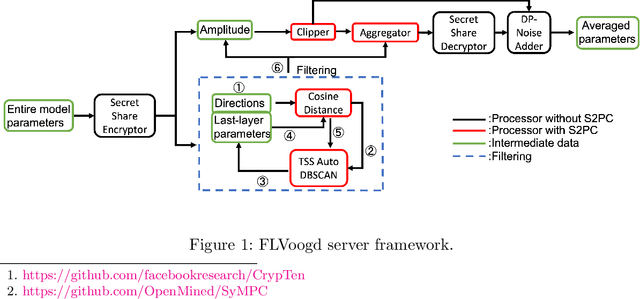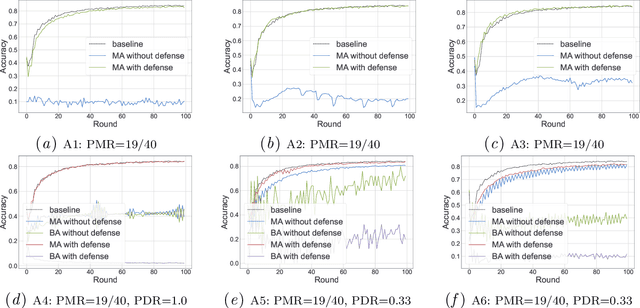Yanqi Qiao
LADDER: Multi-objective Backdoor Attack via Evolutionary Algorithm
Nov 28, 2024Abstract:Current black-box backdoor attacks in convolutional neural networks formulate attack objective(s) as single-objective optimization problems in single domain. Designing triggers in single domain harms semantics and trigger robustness as well as introduces visual and spectral anomaly. This work proposes a multi-objective black-box backdoor attack in dual domains via evolutionary algorithm (LADDER), the first instance of achieving multiple attack objectives simultaneously by optimizing triggers without requiring prior knowledge about victim model. In particular, we formulate LADDER as a multi-objective optimization problem (MOP) and solve it via multi-objective evolutionary algorithm (MOEA). MOEA maintains a population of triggers with trade-offs among attack objectives and uses non-dominated sort to drive triggers toward optimal solutions. We further apply preference-based selection to MOEA to exclude impractical triggers. We state that LADDER investigates a new dual-domain perspective for trigger stealthiness by minimizing the anomaly between clean and poisoned samples in the spectral domain. Lastly, the robustness against preprocessing operations is achieved by pushing triggers to low-frequency regions. Extensive experiments comprehensively showcase that LADDER achieves attack effectiveness of at least 99%, attack robustness with 90.23% (50.09% higher than state-of-the-art attacks on average), superior natural stealthiness (1.12x to 196.74x improvement) and excellent spectral stealthiness (8.45x enhancement) as compared to current stealthy attacks by the average $l_2$-norm across 5 public datasets.
Low-Frequency Black-Box Backdoor Attack via Evolutionary Algorithm
Mar 06, 2024Abstract:While convolutional neural networks (CNNs) have achieved success in computer vision tasks, it is vulnerable to backdoor attacks. Such attacks could mislead the victim model to make attacker-chosen prediction with a specific trigger pattern. Until now, the trigger injection of existing attacks is mainly limited to spatial domain. Recent works take advantage of perceptual properties of planting specific patterns in the frequency domain, which only reflect indistinguishable pixel-wise perturbations in pixel domain. However, in the black-box setup, the inaccessibility of training process often renders more complex trigger designs. Existing frequency attacks simply handcraft the magnitude of spectrum, introducing anomaly frequency disparities between clean and poisoned data and taking risks of being removed by image processing operations (such as lossy compression and filtering). In this paper, we propose a robust low-frequency black-box backdoor attack (LFBA), which minimally perturbs low-frequency components of frequency spectrum and maintains the perceptual similarity in spatial space simultaneously. The key insight of our attack restrict the search for the optimal trigger to low-frequency region that can achieve high attack effectiveness, robustness against image transformation defenses and stealthiness in dual space. We utilize simulated annealing (SA), a form of evolutionary algorithm, to optimize the properties of frequency trigger including the number of manipulated frequency bands and the perturbation of each frequency component, without relying on the knowledge from the victim classifier. Extensive experiments on real-world datasets verify the effectiveness and robustness of LFBA against image processing operations and the state-of-the-art backdoor defenses, as well as its inherent stealthiness in both spatial and frequency space, making it resilient against frequency inspection.
FTA: Stealthy and Robust Backdoor Attack with Flexible Trigger on Federated Learning
Aug 31, 2023Abstract:Current backdoor attacks against federated learning (FL) strongly rely on universal triggers or semantic patterns, which can be easily detected and filtered by certain defense mechanisms such as norm clipping, comparing parameter divergences among local updates. In this work, we propose a new stealthy and robust backdoor attack with flexible triggers against FL defenses. To achieve this, we build a generative trigger function that can learn to manipulate the benign samples with an imperceptible flexible trigger pattern and simultaneously make the trigger pattern include the most significant hidden features of the attacker-chosen label. Moreover, our trigger generator can keep learning and adapt across different rounds, allowing it to adjust to changes in the global model. By filling the distinguishable difference (the mapping between the trigger pattern and target label), we make our attack naturally stealthy. Extensive experiments on real-world datasets verify the effectiveness and stealthiness of our attack compared to prior attacks on decentralized learning framework with eight well-studied defenses.
MULTI-FLGANs: Multi-Distributed Adversarial Networks for Non-IID distribution
Jun 24, 2022



Abstract:Federated learning is an emerging concept in the domain of distributed machine learning. This concept has enabled GANs to benefit from the rich distributed training data while preserving privacy. However, in a non-iid setting, current federated GAN architectures are unstable, struggling to learn the distinct features and vulnerable to mode collapse. In this paper, we propose a novel architecture MULTI-FLGAN to solve the problem of low-quality images, mode collapse and instability for non-iid datasets. Our results show that MULTI-FLGAN is four times as stable and performant (i.e. high inception score) on average over 20 clients compared to baseline FLGAN.
FLVoogd: Robust And Privacy Preserving Federated Learning
Jun 24, 2022



Abstract:In this work, we propose FLVoogd, an updated federated learning method in which servers and clients collaboratively eliminate Byzantine attacks while preserving privacy. In particular, servers use automatic Density-based Spatial Clustering of Applications with Noise (DBSCAN) combined with S2PC to cluster the benign majority without acquiring sensitive personal information. Meanwhile, clients build dual models and perform test-based distance controlling to adjust their local models toward the global one to achieve personalizing. Our framework is automatic and adaptive that servers/clients don't need to tune the parameters during the training. In addition, our framework leverages Secure Multi-party Computation (SMPC) operations, including multiplications, additions, and comparison, where costly operations, like division and square root, are not required. Evaluations are carried out on some conventional datasets from the image classification field. The result shows that FLVoogd can effectively reject malicious uploads in most scenarios; meanwhile, it avoids data leakage from the server-side.
 Add to Chrome
Add to Chrome Add to Firefox
Add to Firefox Add to Edge
Add to Edge